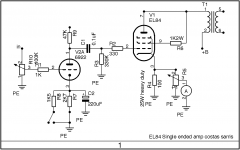Quick question, if I have a power tube that is wired in the conventional configuration where I have a 1K resistor going to the screen from B+ and I want to convert it to UL at 40% tap, do I still need the 1K resistor or does the UL tap now go directly to the screen given that it is at 40% tap?
Thanks
Thanks
Ideally use a resistor if EL34 is used, to protect the amplifier, otherwise for true UL wire G2 directly to the tap.
Also it calls for a 5K OT I have a 5K and I also have a 3.5K
What would happen if I used the 3.5K instead of the 5K?
I'm thinking more current would be higher power, bad idea?
What would happen if I used the 3.5K instead of the 5K?
I'm thinking more current would be higher power, bad idea?
Also it calls for a 5K OT I have a 5K and I also have a 3.5K
What would happen if I used the 3.5K instead of the 5K?
I'm thinking more current would be higher power, bad idea?
UL for EL84 would be 25% tap. Use the appropriate transformer Z for the tube. If you don't have a transformer with 25% screen tap it's not worth the trouble of trading out the transformer if what you have now is just a conventional tranny. And as a matter of fact, Ed Laurent of Dynaco did an EL84 type amp with Dynaco OPT's and didn't even use the tap for the screen.
Your 1K resistor is not going from the screen to B+ (this is referred to as "wired as a pentode"), it's going from the screen to the plate (this is referred to as "triode wiring").
Nothing about the design you linked to is suitable for UL or pentode wired finals.
R4 should absolutely have a capacitor across it if you are attempting to get any kind of bass response out of the amp.
Nothing about the design you linked to is suitable for UL or pentode wired finals.
R4 should absolutely have a capacitor across it if you are attempting to get any kind of bass response out of the amp.
Interesting, I thought all UL taps were at approx 40%.
Is there a way to find what % Tap is used for a specific tube or is the EL84 somehow different and why?
Is there a way to find what % Tap is used for a specific tube or is the EL84 somehow different and why?
Your 1K resistor is not going from the screen to B+ (this is referred to as "wired as a pentode"), it's going from the screen to the plate (this is referred to as "triode wiring").
Nothing about the design you linked to is suitable for UL or pentode wired finals.
R4 should absolutely have a capacitor across it if you are attempting to get any kind of bass response out of the amp.
If R6 was at B+ it would be pentode mode so I was thinking of making it UL pentode mode instaed of triad mode shown in the schematic.
If I put a Cap at R4 would 47uf be good, that seems to be that value I used most of the time.
Interesting, I thought all UL taps were at approx 40%.
Is there a way to find what % Tap is used for a specific tube or is the EL84 somehow different and why?
To understand UL better than the crowd, do some research on Acrosound it's creator. "UL" and "screen taps" are not the same thing. Each tube has it's own tap point and EL84 are way off 40%. Some tubes have the 40% UL value, some 43%... Some may argue it's not worth the distinction but for the EL84 it's way off.
Last edited:
To understand UL better than the crowd, do some research on Acrosound it's creator. "UL" and "screen taps" are not the same thing. Each tube has it's own tap point and EL84 are way off 40%. Some tubes have the 40% UL value, some 43%... Some may argue it's not worth the distinction but for the EL84 it's way off.
Awesome, thanks, just looking at it quickly, it looks far more complicated then I thought is was. Figures 😱
If R6 was at B+ it would be pentode mode so I was thinking of making it UL pentode mode instaed of triad mode shown in the schematic.
If I put a Cap at R4 would 47uf be good, that seems to be that value I used most of the time.
Is this not what you've built?
This is a triode strapped power amp.
If you want to change it to a pentode wired amp or an UL wired amp, you're going to need a different driver and feedback at the bare minimum, with perhaps also a change in output transformers.
Attachments
Is this not what you've built?
This is a triode strapped power amp.
If you want to change it to a pentode wired amp or an UL wired amp, you're going to need a different driver and feedback at the bare minimum, with perhaps also a change in output transformers.
I haven't started building anything yet. Still looking at a mod of the plan. I wanted to use a UL rather than the Triode strap in the schematic, I thought it would be an easy mod, but maybe not, not sure where to find a 20% tap OT. I also was thinking of using a 12a(*)7 driver. Change the Cathode resistor to 1.2k and a Cap on the EL84 tube. Would a 12aq(*)7 a better driver? Would using shade be good enough for feedback or do I want to come off the other side of the OT?
No, it's not an easy mod. There are major differences between a 12AX7, 12AT7, 12AV7, and 12AU7. You need to pick the one suitable for your needs, no one circuit will magically work well with them all.
If you want to build a single ended EL84 amp with Schade feedback, there are published designs out there already.
If you want to build a single ended EL84 amp with Schade feedback, there are published designs out there already.
I bench tested a cloned version of that amplifier about a year ago. It managed somewhat less than one watt at clipping. Hardly worth the time & effort involved.😀
But sounded OK at low level, OK if that satisfies the need.
To understand UL better than the crowd, do some research on Acrosound it's creator. "UL" and "screen taps" are not the same thing. Each tube has it's own tap point and EL84 are way off 40%. Some tubes have the 40% UL value, some 43%... Some may argue it's not worth the distinction but for the EL84 it's way off.
Alan Blumlein invented the UL cct in 1937 & made many other important contributions to the art.
Alan Blumlein - Wikipedia
The term Ultra Linear was applied to the cct by Hafler & Keroes as a way of selling the tapped OPTs made by their company. UL was a marketing term, just as HEMI still is for Chrysler.🙂
The UL tap lowers the effective plate rp of the tube so that is is better able to drive a complex load such as a loudspeaker.
Some examples of rp change of common tubes attached.
Attachments
-
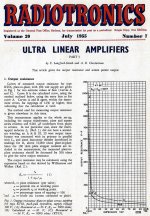 Calculation of Ultralinear Plate Resistance Radiotronics Magazine p1.jpg639.7 KB · Views: 158
Calculation of Ultralinear Plate Resistance Radiotronics Magazine p1.jpg639.7 KB · Views: 158 -
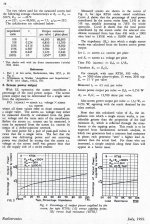 Calculation of Ultralinear Plate Resistance Radiotronics Magazine p2.jpg580.6 KB · Views: 159
Calculation of Ultralinear Plate Resistance Radiotronics Magazine p2.jpg580.6 KB · Views: 159 -
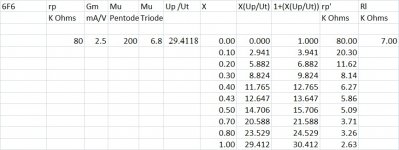 6F6 rp vs UL FB Factor.jpg91.2 KB · Views: 150
6F6 rp vs UL FB Factor.jpg91.2 KB · Views: 150 -
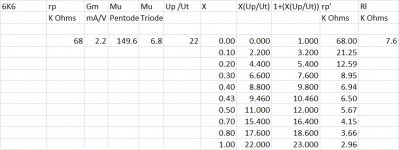 6K6 rp vs UL FB Factor.jpg90.1 KB · Views: 136
6K6 rp vs UL FB Factor.jpg90.1 KB · Views: 136 -
 6V6_6AQ5 rp vs UL FB Factor.jpg88.6 KB · Views: 63
6V6_6AQ5 rp vs UL FB Factor.jpg88.6 KB · Views: 63 -
 6L6 rp vs UL FB Factor.jpg85.3 KB · Views: 78
6L6 rp vs UL FB Factor.jpg85.3 KB · Views: 78 -
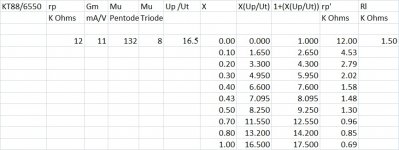 6550_KT88 rp vs UL FB Factor.jpg90 KB · Views: 73
6550_KT88 rp vs UL FB Factor.jpg90 KB · Views: 73 -
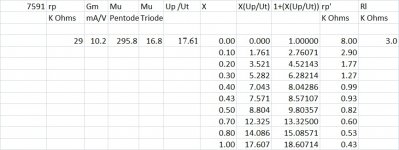 7591 rp vs UL FB Factor.jpg93.1 KB · Views: 77
7591 rp vs UL FB Factor.jpg93.1 KB · Views: 77
The term Ultra Linear was applied to the cct by Hafler & Keroes as a way of selling the tapped OPTs made by their company. UL was a marketing term, just as HEMI still is for Chrysler.🙂
Yeah. My first car, an early 50s Riley, had hemi heads.
Alan Blumlein invented the UL cct in 1937 & made many other important contributions to the art.
Don't mistake or conflate UL with a generic screen tap. It's not contested that Blumlein had an early patent for a primary/screen tap objective, but it had no claim for HIFI utility. His claim is for protection of the outputs by reducing the high voltage spike in a sudden loss of load. That's all. While Smith's article and data with regard to plate resistance over a range of screen taps may be interesting, it shows he also didn't understand or accept the UL distinction. Hafler had to set him straight in some amp articles he published. Why pick just Part 3 to use? Is that the series of articles Hafler busted him on?
Last edited:
UL for EL84 would be 25% tap. Use the appropriate transformer Z for the tube. If you don't have a transformer with 25% screen tap it's not worth the trouble of trading out the transformer if what you have now is just a conventional tranny. And as a matter of fact, Ed Laurent of Dynaco did an EL84 type amp with Dynaco OPT's and didn't even use the tap for the screen.
Why is 25% screen tap best for EL84? In your response give a proof.🙂
cct = circuit
- Home
- Amplifiers
- Tubes / Valves
- UL conversion
